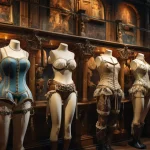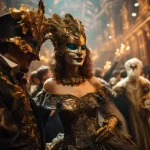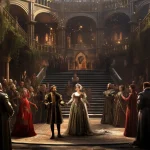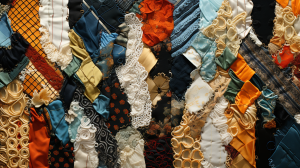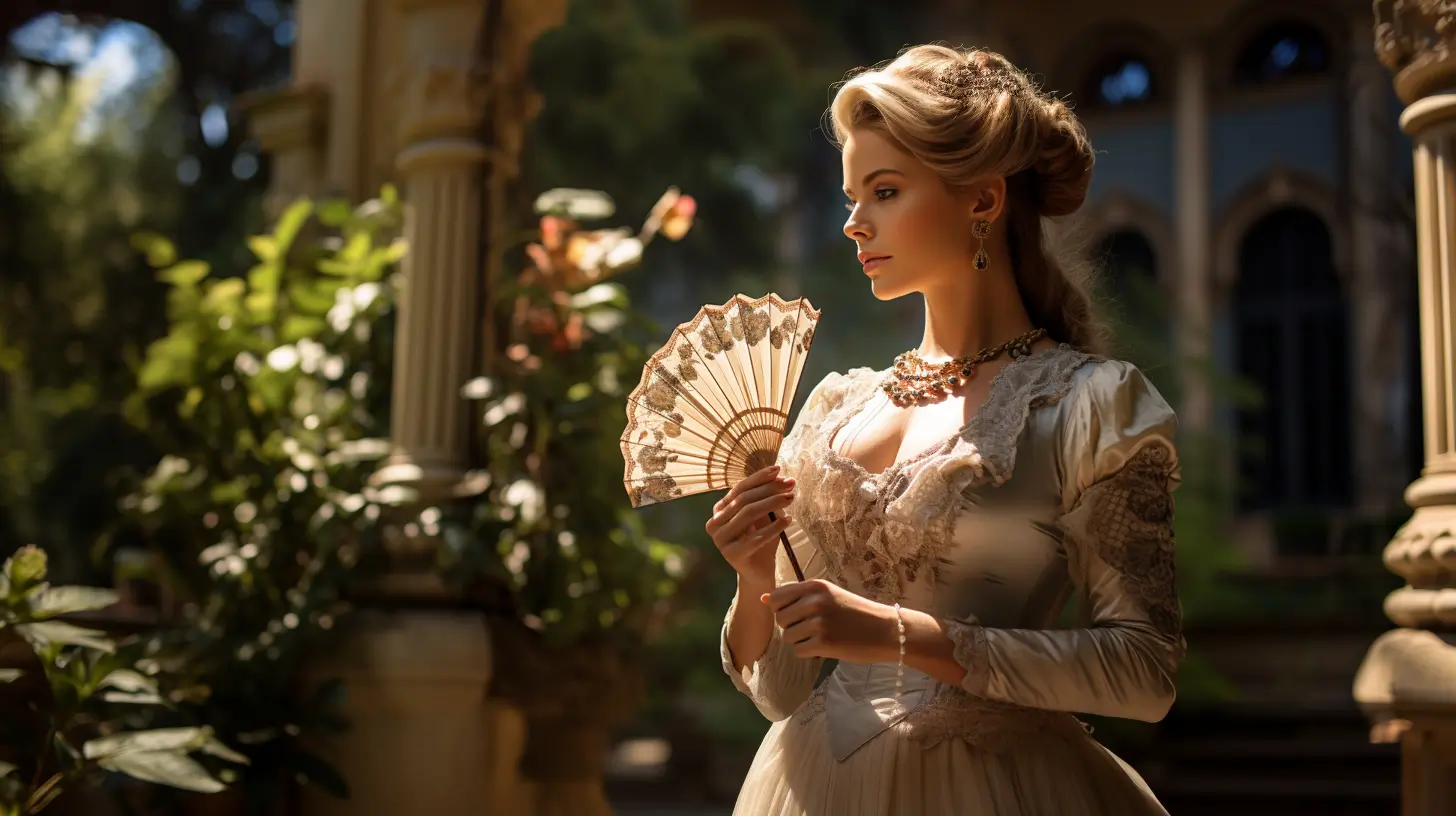
🌟 Unveiling the Victorian Splendor 🌟
In the hushed corridors of time, where the echoes of yesteryears’ elegance still resonate, there exists a realm of fashion that transports us to an era like no other. Welcome to a mesmerizing journey through the enchanting world of Victorian women’s fashion. 🕰️👗
Introduction
In this captivating exploration, we will delve deep into the intricate layers of an era that left an indelible mark on the annals of fashion history. The Victorian era, spanning from 1837 to 1901, was a period of opulence, restraint, and transformation. It was a time when fashion was not merely a reflection of personal style but a potent force shaping both individual silhouettes and society at large.
👑 Victorian women’s fashion stands as a testament to the fusion of artistry and societal values, where clothing was not just attire but a language that spoke volumes about the wearer. It’s a world where corsets sculpted hourglass figures, bustles swayed with grace, and fabrics whispered stories of wealth and status.
📜 Join me as we unravel the tapestry of Victorian fashion, exploring the intricacies of its silhouette, the enchantment of elaborate bustles, the layers of petticoats and crinolines, the choice of fabrics and materials, and the role of accessories that adorned the Victorian women.
In this journey, we will not only appreciate the visual extravagance but also decipher the cultural significance embedded in every stitch. We’ll witness how fashion was a reflection of societal shifts, and we’ll marvel at the craftsmanship that transformed fabrics into wearable art.
🌟 So, fasten your metaphorical corset and prepare to step into the opulent world of Victorian women’s fashion. As we embark on this adventure, let us travel through time and explore the legacy of an era that continues to influence contemporary fashion. Our journey begins with a glimpse into the broader context of the Victorian era.
Silhouette Transformation
In the midst of the Victorian era’s bustling streets and opulent ballrooms, one could not help but be captivated by the striking transformation of women’s silhouettes. 🌆✨
The Corset Craze
In the quest for the ideal Victorian figure, there existed an undergarment that held an almost mythical sway: the corset. 🌸
👗 The corset, fashioned from a myriad of fabrics, was a masterpiece of both fashion and engineering. Its primary role? To cinch the waist, achieving that coveted hourglass shape. The essence of Victorian women’s fashion lay in this precise cinching. 🕳️
Imagine a beautifully adorned corset, its laces intricately woven, hugging the wearer’s midsection. The pressure it exerted was undeniable, and yet, for many, it was a symbol of grace and refinement.
But beneath the allure lay a dichotomy, as the corset could both empower and restrict. It sculpted the body, but it also limited mobility. The corset was a garment of contradictions, embodying the complexities of Victorian fashion. 🌹
The Hourglass Figure
Victorian women aspired to attain the ultimate silhouette: the hourglass figure. ⏳🌟
With the waistline constricted by the corset, the upper body and hips became the focal points of attention. Bodices and skirts were carefully designed to emphasize these areas. Layers of petticoats added volume below, creating a dramatic contrast.
The Victorian woman, adorned in her hourglass silhouette, was a vision of grace and poise. 💃
Picture an image of a Victorian lady, impeccably dressed, with a slender waist, her gown flowing gracefully to the ground. The corset, concealed beneath layers of fabric, subtly but profoundly shaped her form.
As we venture further into the world of Victorian women’s fashion, we shall continue to explore the fascinating elements that contributed to this remarkable era of style. Our next stop: the world of elaborate bustles that added an extra layer of charm to the Victorian silhouette.
Image Description: A photorealistic image of a Victorian lady wearing a corset and an elaborate gown, showcasing the cinched waist and hourglass silhouette. The gown is adorned with intricate lace and embroidery, and the corset’s laces are visible, emphasizing the waist. The lady stands in a Victorian drawing room with ornate furniture and drape
Elaborate Bustles
As we continue our journey through the captivating world of Victorian women’s fashion, our path takes us to an element that added a touch of enchantment and extravagance to the already elaborate ensembles: the bustle. 🌼✨
Introduction to Bustles
In the grand canvas of Victorian attire, the bustle emerged as a fascinating feature. Imagine it as a sculptural extension, gracefully draped at the back of a lady’s gown. 🖼️👗
This remarkable fashion innovation served both form and function. Bustles were designed to create volume and fullness at the rear of the dress, often resembling a cascading waterfall of fabric. They transformed a woman’s silhouette into a vision of elegance and opulence.
🌟 Picture a Victorian lady, her gown flowing gracefully, with the bustle enhancing her presence as she moves. It was a statement piece, a focal point that drew the eye and added an air of mystique to her ensemble.
Types of Bustles
Diving deeper into this realm, we find a diverse array of bustle styles, each with its unique charm and purpose. The Victorian era witnessed an evolution in bustle designs, reflecting changing tastes and aesthetics. 🌹
- The Waterfall Bustle: Imagine a gentle cascade of fabric, reminiscent of a waterfall, flowing gracefully down the back of a gown. This bustle type created an ethereal and romantic aura.
- The Shelf Bustle: In contrast, the shelf bustle presented a more structured and angular appearance. It was like a petite shelf protruding from the back, adding a touch of architectural sophistication to the silhouette.
- The Bowed Bustle: This style incorporated bows and ribbons, adding a whimsical and playful element to the ensemble. Bowed bustles were favored for their charming and flirtatious appeal.
- The Caged Bustle: An innovation of its time, the caged bustle utilized wire frames to support the fabric, achieving a distinctive and striking look. It offered a balance between structure and fluidity.
In the absence of photographs, artists of the era captured these bustle styles in exquisite illustrations, preserving the essence of Victorian fashion. A placeholder for such an illustration would depict a Victorian lady in a resplendent gown, showcasing the specific type of bustle with intricate details and elegance.
As we conclude our exploration of bustles, we gain a deeper understanding of the nuances that contributed to the charm of Victorian women’s fashion. Our next stop will unveil the layers of petticoats and crinolines that played a pivotal role in shaping this era’s iconic silhouette.
Image Description: Placeholder for an illustration depicting a Victorian lady wearing a gown with an elaborate bustle. The illustration showcases the intricate details of the bustle style, including bows, ribbons, and cascading fabric. The lady stands in a Victorian garden with lush greenery and blooming flowers, creating a picturesque scene of Victorian elegance.
Layers of Petticoats and Crinolines
Now, dear readers, as we continue our enchanting journey through the corridors of Victorian women’s fashion, our path leads us to the layers that added volume and drama to their opulent ensembles: petticoats and crinolines. 🌼👗
The Petticoat Hierarchy
Picture this: Victorian ladies adorned themselves with layers of petticoats, each serving a specific purpose. These undergarments were not mere afterthoughts but integral components in achieving the desired silhouette. 🌟👑
- The Chemise: The foundation of it all, the chemise, was worn closest to the skin. It acted as a barrier between the body and the outer layers, ensuring comfort and hygiene.
- The Drawers: These wide-legged undergarments were essential for modesty and ease of movement, especially when engaging in various activities.
- The Corset Cover: Designed to protect the outer clothing from the corset’s laces and prevent any friction, the corset cover was both practical and decorative.
- The Petticoats: A series of petticoats followed, each with a specific role. The initial layers were usually made of lightweight materials, gradually increasing in weight and stiffness as one moved outward. These petticoats added volume and supported the structure of the outer skirt.
Crinolines and Hoops
As we venture deeper into the layers, we encounter an innovation that truly revolutionized Victorian fashion: the crinoline. 🌀💃
Imagine a lightweight framework of hoops or whalebone, creating a bell-like shape that extended from the waist down. 🎀
The crinoline had a profound impact on fashion, allowing for a more exaggerated silhouette while offering greater freedom of movement compared to the earlier layers of petticoats. It was both practical and dramatic, creating a sense of enchantment as Victorian ladies glided through ballrooms and gardens.
As you can see in the image below, the crinoline gracefully supports the outer layers of the gown, creating a captivating silhouette. 🖼️🌹
Image Description: A photorealistic image depicting a Victorian lady wearing a crinoline beneath her elaborate gown. The crinoline’s hoops are visible under the skirt, creating a distinct bell-shaped silhouette. The lady stands in a Victorian garden surrounded by lush foliage and blooming flowers, capturing the elegance and charm of the era.
Fabrics and Materials
As we continue our immersive voyage into the depths of Victorian women’s fashion, we find ourselves in a realm where the very essence of attire is shaped by the choice of materials and fabrics. 🌟👗
Popular Fabrics
In the grand ballrooms and salons of the Victorian era, fabrics were carefully selected to create stunning visual and tactile experiences. The array of fabrics available in this period was vast and offered a wide spectrum of colors, textures, and patterns.
- Silk: The undisputed queen of Victorian fabrics, silk reigned supreme. It was favored for its luxurious sheen and softness. Imagine the gentle rustle of a silk gown as a Victorian lady makes her entrance into a candlelit ballroom.
- Velvet: Velvet added a touch of opulence and depth to Victorian ensembles. The fabric’s plush texture and rich colors made it a symbol of status and sophistication. Picture a velvet bodice adorned with intricate embroidery.
- Satin: Satin, with its smooth and glossy surface, was often chosen for evening gowns and elaborate trims. It caught the light and created a mesmerizing effect as Victorian ladies twirled on the dance floor.
- Cotton: While silk and velvet were reserved for special occasions, cotton was the workhorse of everyday wear. Crisp and practical, it embodied the modesty of the era’s daytime fashion.
Ornate Embellishments
But it wasn’t just the choice of fabric that defined Victorian fashion; it was also the meticulous attention to embellishments and details that adorned these garments.
- Embroidery: Intricate embroidery added a touch of artistry to gowns and bodices. Patterns of flora and fauna, as well as intricate scrollwork, transformed fabric into a canvas of expression.
- Lace: Delicate lace, often handcrafted, adorned collars, cuffs, and the edges of gowns. It evoked a sense of femininity and elegance, creating a visual masterpiece.
- Ribbons and Bows: Imagine ribbons and bows meticulously placed on a gown, enhancing its charm and grace. These playful details added a touch of flirtation and whimsy.
- Buttons and Brooches: Buttons and brooches made of precious materials like mother-of-pearl or gemstones were not only functional but also served as exquisite accents.
As we venture further into the world of Victorian women’s fashion, we appreciate that it’s not just the garments but also the intricate details that bring them to life. Our next destination will be an exploration of accessories that completed the Victorian ensemble.

The Role of Accessories
In the grand stage of Victorian fashion, where every garment was a masterpiece, it was the accessories that added the final strokes to this portrait of elegance and refinement. 🎭✨
Introduction to Accessories
Imagine, if you will, a Victorian lady preparing for a soirée. Her gown, meticulously chosen for its fabric, silhouette, and embellishments, is almost complete. But it’s the accessories that will breathe life into her ensemble, turning it into a statement of both style and societal standing.
Head Adornments
The crowning glory of any Victorian lady’s attire was her headwear. 👒
- Hats: Picture a wide-brimmed hat adorned with silk flowers and feathers, casting a delicate shadow over a lady’s face. Hats were a canvas for creativity, each one telling a unique story.
- Bonnet: A bonnet, with its ribbon ties and lace trimmings, was a symbol of modesty and femininity. It framed the face delicately, adding a touch of charm to the overall look.
- Veils: For formal occasions, veils added an air of mystery and allure. They draped elegantly over the face, leaving only a hint of the wearer’s features visible.
Gloves and Fans
Accessories were not just about aesthetics; they also served practical purposes. 🧤🌬️
- Gloves: Gloves, often made of fine kid leather, were a sign of refinement. They protected the hands from the elements and added sophistication to a lady’s gestures.
- Fans: Delicate handheld fans were both functional and decorative. They kept ladies cool in the heat of a ballroom and were also used as subtle forms of communication.
Jewelry and Trinkets
The Victorian era saw a resurgence of interest in jewelry, with intricate designs inspired by nature and sentimentality. 💍🌿
- Lockets: Lockets, often containing portraits or locks of hair, held sentimental value. They were worn close to the heart, signifying affection and remembrance.
- Cameos: Cameos, carved from shell or stone, depicted intricate scenes or profiles. They were cherished for their artistry and were often passed down through generations.
- Brooches and Pins: Brooches and pins adorned collars, bodices, and hats, adding a touch of sparkle and personal flair.
Parasols and Umbrellas
No Victorian lady would step out without a parasol or umbrella, protecting her fair complexion from the sun and rain. ☂️🌞
- Parasols: These delicate sunshades were not only functional but also stylish. They were made from various fabrics and often matched the gown.
- Umbrellas: For rainy days, umbrellas with intricate handles and decorative details shielded the Victorian lady while adding a touch of elegance to her ensemble.
As we journey through the realm of Victorian women’s fashion, we see that it’s not just the garments but also the carefully chosen accessories that speak volumes about the wearer. In our next segment, we will delve into the cultural significance of Victorian fashion, exploring how clothing choices mirrored the societal shifts of the era.
Image Description: A placeholder for an image showcasing a Victorian lady elegantly holding a lace fan in her gloved hand. The lady is depicted in a lush garden setting, with dappled sunlight filtering through the foliage, creating an atmosphere of timeless beauty and grace.
Victorian Women in Society
Our journey through the exquisite world of Victorian women’s fashion takes us beyond the garments and accessories, unveiling the intricate interplay between clothing and the societal roles of women in this era. 🌟👩👧👧
The Constrained Ideal
In the Victorian era, societal expectations of women were both deeply ingrained and rigorously enforced. The image of the ideal Victorian woman was one of grace, modesty, and domesticity. Picture a world where women were expected to be the moral compass of the family, nurturing the values of piety and purity. 🏡❤️
The Influence of Fashion
Fashion, as it so often does, mirrored the prevailing attitudes of the time. The clothing of Victorian women served as a visual representation of their place in society.
- The Corset: The infamous corset, while celebrated for its ability to create an hourglass figure, also symbolized the physical constraints placed on women. The tight lacing was seen as a reflection of a woman’s self-control and virtue.
- The Crinoline: The crinoline, with its expansive silhouette, gave an impression of fragility and vulnerability. It reinforced the idea that women should be delicate and dependent.
Dress Codes and Social Status
In the grand tapestry of Victorian society, clothing served as a marker of social standing. Different classes had distinct dress codes, and even within the upper echelons, nuances in attire indicated one’s wealth and position.
Imagine a scene where a lady’s gown, carefully chosen fabrics, and subtle embellishments convey not just her personal taste but also her family’s standing in society.
The Advent of Rational Dress
As the Victorian era progressed, some women began to challenge the limitations imposed by their attire. The rational dress movement emerged, advocating for more comfortable and practical clothing. Picture Victorian ladies in reform dresses, shedding the constraints of corsets and voluminous skirts, as they sought greater freedom of movement. 🙌👗
The Suffragette Movement
Towards the latter part of the Victorian era, women’s fashion became intertwined with the fight for women’s suffrage. Suffragettes used fashion as a form of protest, adopting specific colors and styles to express their solidarity and demands for equal rights.
Our exploration of Victorian women’s fashion now leads us to the dynamic intersection of clothing and societal norms. In our next section, we will delve into the mesmerizing world of design and craftsmanship, celebrating the artistry that went into creating these remarkable garments.
Victorian Fashion Legacy
As we near the culmination of our journey through the annals of Victorian women’s fashion, we arrive at a crossroads where the echoes of this remarkable era continue to resonate in the tapestry of fashion history. 🌟🕰️
Influence on Later Eras
The Victorian era may have concluded, but its influence endured throughout the 20th century and beyond. 🕒✨
Subcategory 1: Influence on Later Eras
The Victorians’ penchant for opulence, intricacy, and attention to detail left an indelible mark on the world of fashion. 🌹💫
- Silhouettes: Elements of the Victorian silhouette persisted into the 20th century. Think of the high necklines, puffed sleeves, and cinched waists that made a comeback in various fashion cycles.
- Fabrics and Textures: The fascination with sumptuous fabrics and textures continued. Velvet, lace, and silk found their place in 20th-century couture, evoking the timeless allure of Victorian fashion.
- Corsetry: The allure of a well-defined waistline transcended eras. Corsets and girdles were still utilized to achieve that coveted hourglass figure.
Subcategory 2: Revival and Modern Interpretations
Fashion is cyclical, and the Victorian era experienced a revival in the modern age, breathing new life into its design aesthetics. 🔄👗
- Neo-Victorianism: The late 20th century saw the emergence of Neo-Victorian fashion. Designers and enthusiasts revisited Victorian aesthetics, infusing them with a contemporary twist.
- Steampunk Subculture: Steampunk, a subculture that draws inspiration from the Victorian era’s steam-powered technology, created a unique style that combined elements of the past with futuristic imaginings.
Contemporary Fashion
Even in the 21st century, Victorian-inspired fashion continues to capture the imagination of designers and fashion enthusiasts alike. 🌟👠
- Runway Collections: Runway collections have often featured Victorian-inspired pieces, from ruffled blouses to long skirts. These garments pay homage to an era of elegance and sophistication.
- Bridal Wear: Wedding gowns often incorporate Victorian elements, such as lace overlays, high necklines, and long trains, evoking a sense of timeless romance.
- Everyday Fashion: Everyday fashion can also be touched by Victorian aesthetics, with the incorporation of lace trims, vintage-inspired accessories, and corset-style belts.
As we gaze upon the legacy of Victorian women’s fashion, we see how its influence has transcended time, leaving an indelible mark on the world of style. In our final section, we will conclude our journey, reflecting on the enduring appeal and cultural significance of this remarkable era.
Conclusion: The Timeless Allure of Victorian Women’s Fashion
As our journey through the enchanting world of Victorian women’s fashion draws to a close, we find ourselves captivated by the enduring allure of an era that left an indelible mark on the grand tapestry of fashion history. 🌹👗
Influence on Later Eras
In our exploration of the Victorian fashion legacy, we discovered how this era’s opulence and attention to detail persisted beyond its time. Elements such as silhouette, fabrics, and corsetry continued to influence the fashion landscape well into the 20th century. The image of a well-dressed Victorian lady with her cinched waist and intricate lacework was a vision that transcended time, reminding us that great style knows no boundaries.
Revival and Modern Interpretations
The resurgence of Victorian fashion in the late 20th century breathed new life into its design aesthetics. The Neo-Victorian movement and the unique subculture of Steampunk revitalized Victorian-inspired fashion, blending elements of the past with futuristic imagination. This revival allowed us to see the timelessness of Victorian fashion through a modern lens, reinterpreting its elegance for a new generation.
Contemporary Fashion
In the 21st century, Victorian-inspired fashion remains a source of fascination. Runway collections continue to feature Victorian elements, and bridal wear often incorporates lace, high necklines, and long trains, evoking a sense of timeless romance. Everyday fashion can also be touched by Victorian aesthetics, reminding us that the allure of this era endures in our daily lives.
Image Placeholder: Imagine an image capturing a contemporary fashion runway, where a model gracefully walks in a Victorian-inspired gown. The intricate lace and elegant silhouette are juxtaposed against the modern backdrop, symbolizing the fusion of past and present in fashion.
As we reflect on this captivating journey through Victorian women’s fashion, we are reminded that clothing is more than mere attire; it is a reflection of society, culture, and individual expression. The Victorian era, with its rich tapestry of style, continues to inspire and influence the way we dress and define ourselves.
With a newfound appreciation for the nuances of this era, we bid adieu to our exploration of Victorian women’s fashion. Our final section will serve as a poignant farewell, inviting readers to continue their fashion journey, armed with a deeper understanding of how the past shapes the present.
Farewell and Continuing the Journey
As we reach the end of our enthralling expedition into the world of Victorian women’s fashion, it’s time to bid adieu to this particular chapter while encouraging you to embark on your own exploration of fashion’s rich history. 🌟👋
Reflecting on Our Journey
Our journey through the annals of time, guided by the elegance and refinement of Victorian women’s fashion, has been nothing short of captivating. We’ve unwrapped the layers of garments, accessories, and societal norms that defined this remarkable era. From the intricacies of corsetry to the enduring influence on contemporary fashion, we’ve traced the footsteps of Victorian style.
Continuing Your Fashion Odyssey
As you step away from this virtual time machine, consider this not as an ending but as an invitation to delve deeper into the endless tapestry of fashion history. The annals of time are filled with sartorial stories waiting to be discovered. Whether it’s the rebellious Roaring Twenties, the minimalist elegance of the 1960s, or the avant-garde creations of the present day, fashion history is a vast playground for exploration.
Image Placeholder: Imagine an image featuring an antique-looking map, where intricate illustrations of various fashion eras mark different destinations. Each era is a unique stop in the journey of fashion history, waiting for curious minds to explore.
A Heartfelt Thank You
Before we part ways, I extend my heartfelt gratitude for joining me on this immersive journey through the annals of fashion history. Your curiosity and appreciation for the nuances of style have made this exploration all the more meaningful.
Remember, fashion is not just about clothing; it’s a reflection of society, culture, and individual expression. The next time you choose an outfit, consider the stories it tells and the history it carries with it.
As we conclude this chapter, I encourage you to stay curious, keep exploring, and let your passion for fashion history continue to flourish. The past is a treasure trove of inspiration, and the future of fashion is in your hands.



